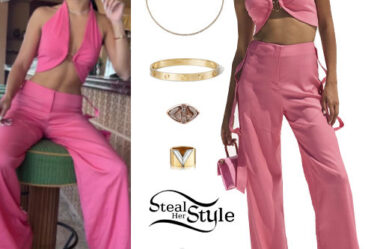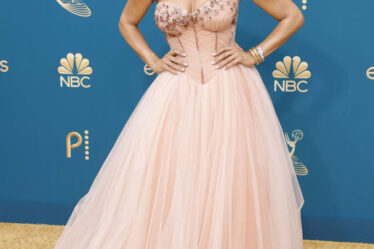
Between rising interest rates, increased competition and slow-moving M&A dealflow, beauty founders – and their investors – are likely hedging their bets on their eventual exits.
British cosmetics brand Refy is betting that the best is yet to come.
Co-founder and chief executive Jenna Meek thinks the business can achieve a multi-billion-dollar ($2.7 billion to be exact) valuation in around seven years, due in part to an adolescent goal she set herself — hence the specificity of the figure — but also because she believes it can sustain its growth trajectory.
Founded in 2020 by Meek and the influencer Jess Hunt, who serves as the brand’s creative director, Refy cultivated a direct-to-consumer business with three eyebrow products designed to recreate Hunt’s signature bushy-yet-groomed brows. (Meek previously launched the hair colour brand Shrine; she sold it earlier this year to focus on Refy.)
It’s since expanded, and now offers a full face of makeup products and recently debuted skincare, and is stocked in Selfridges in the UK and Sephora in the US. It’s on track to generate $85 million in sales this year; Meek says it will break $130 million in sales by 2026, with profit margins hovering steadily around 37 percent.
Part of Meek’s valuation goal is to set an acquisition price tag. But it’s also driven by a desire to establish Refy as a lasting brand. “We’re building a brand that is for the future … [we can] stand next to a Byredo, an Aesop … it’s to prove we built the brand correctly,” said Meek. Puig purchased the former in 2022 for $1 billion, and L’Oréal purchased the latter for $2.5 billion in 2023 at around a four times revenue multiple.
Cognisant that influencer-led brands often have a short shelf life, Meek has been working to mature the brand’s image to help it establish itself as a longer-term player.
Still, image is only half the battle. “People are underwriting things fairly cautiously … [strategic buyers] are looking for a lot of proof points, like future runway and growth opportunities,” said Marko Horvat, a managing director at investment bank Raymond James.
As Meek and Hunt still own the entirety of the business, there’s no external pressure to make them sell before they’re ready. However, many beauty companies that get acquired for 10-figure sums spend some time in investor ownership before being snapped up.
To achieve its goal, Refy will need to continue growing generationally and geographically, whilst not losing its brand identity – and building out a product assortment that encompasses both staples and special treats.
Your Skin, But Better
While Hunt’s two million Instagram followers are a boon, the beauty industry has no shortage of indie hopefuls, especially in the influencer sphere. Despite the breakout successes of lines like Marianna Hewitt and Lauren Ireland’s skincare line Summer Fridays, others have struggled to stand out in the crowded beauty landscape, or have been hamstrung by dips in their famous face’s popularity: Morphe went bankrupt in 2023 after failing to bounce back from scandals tied to partner influencers.
Refy is hoping its appeal will be broadened by creating a cool, but not aloof, brand identity, and also offering products at the lower end of the premium spectrum, with many best sellers around $20-$25. Competitor brands like Saie, Kosas and Glossier tend to sit more in the $40 to $50 bracket.
“I can’t imagine we’d go higher than £40 ($52),” said Meek.
One way the brand keeps costs low is with sleek, simple packaging, in muted grey, beige and cream shades and cast in lightweight recyclable plastic. “I don’t want someone to buy them because they like the packaging, I want them to buy it because they’re going to love the product,” said Meek.
The key to an enduring collection is to balance staple products that consumers repurchase regularly with trending products that generate excitement, said Jessica Ramirez, a senior analyst at retail and brand advisory firm Jane Hali Associates.
Refy’s initial launches included Brow Sculpt, $24, a waxy product with a dual-sided brush to create an extreme brushed-up, or “laminated” look, and Lip Sculpt, $26, a hybrid product that contained both a pigment for the lips and “setting” product to fix in place. They were attention-grabbing, and remain amongst its best-sellers but, for consumers who don’t have especially full brows or lips, the products may not yield the same results. The brand has subsequently launched more approachable variations like lip glosses, brow pencils and balm-like lip stains.
Current trends favour a more natural, fresh-faced look — often referred to as “clean girl” — something Refy’s products are well-designed for. But the brand also wants to have a bit more oomph. Meek suspects that some competitor brands who use marketing where the user “just puts two dots on [their] face” can feel exclusionary to some shoppers. Meek says their customer wants more: “We want dramatic results, but we want to still look really natural.”
Broadening Appeal
To land a $2.7 billion price tag requires grit. More specifically, it requires growing a forecasted $130 million in sales closer to $500 million, reaching consumers outside of the Gen-Z and Millennial brackets, and fending off potential knockoffs along the way.
“As you get bigger, there are more targets on your back,” said Horvat, warning of well-designed and well-capitalised competitor brands. At the same time, “Strategic buyers are not buying these brands to stand still,” Horvat added. “They need to have clear, tangible growth levers available … you can’t be tapped out with every retailer on the planet.”
For now, Refy is keeping its focus on the US and UK markets, and on wholesale; it recently hired a US-based sales and education director who previously worked at skincare maker Drunk Elephant and clean cosmetics line Ilia to visit stores and train staff.
It will also need to continue to hone its product offering and brand image to edge out any competitors. To that end, it’s trying to focus on building a “community” — earlier this summer, it took some customers on a brand trip to Mallorca, Spain in July and also offered free makeovers and photoshoots in Los Angeles. It also inked a sponsorship deal at Paris Fashion Week in September, previewing a new lip product at the Christopher Esber show, a move intended to highlight the brand’s new elevated look.
Still, its efforts to connect with their audience don’t always pay off. Earlier this year, the brand launched an apparel offering called “Refy Curated”, featuring items such as t-shirts, sweaters and earrings (Meek previously worked in product development for fashion houses including Burberry). Meant to extend the brand’s lifestyle appeal Meek said instead, it was misunderstood as a move toward becoming a fashion brand. It axed the project, but gifts merchandise like hats and sweatshirts to influencers and top customers. These products are “brand builders,” said Meek, and not “sales drivers.”
Refy’s focus needs to stay laser sharp, and quickly work out how to future-proof its offering — Ramirez said it needs to stay “fierce” on competition and evolve its offering strategically.
“The bar was always high. It has gotten higher,” said Horvat.
Sign up to The Business of Beauty newsletter, your complimentary, must-read source for the day’s most important beauty and wellness news and analysis.



